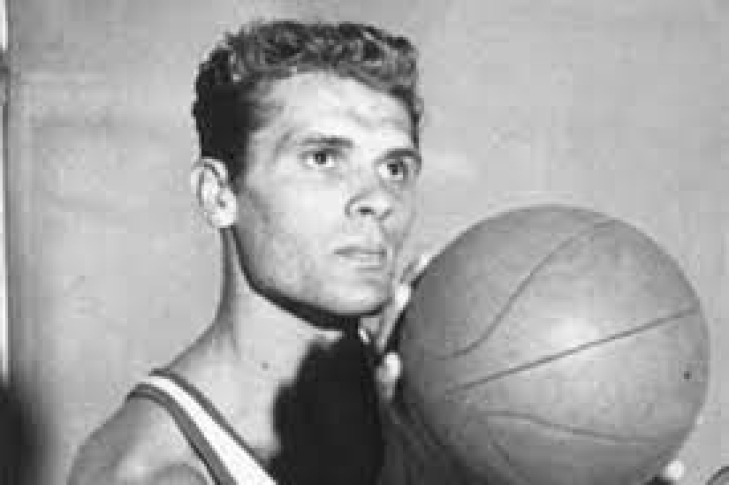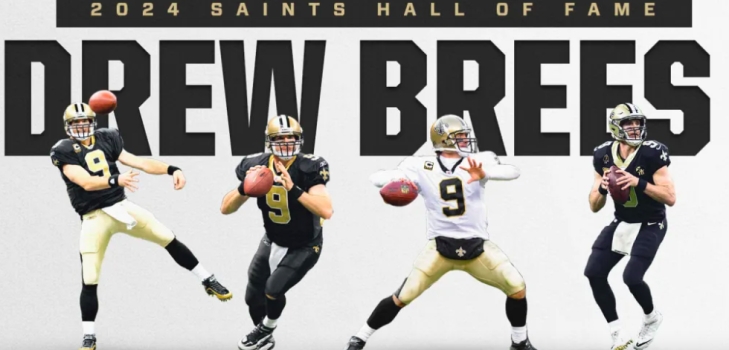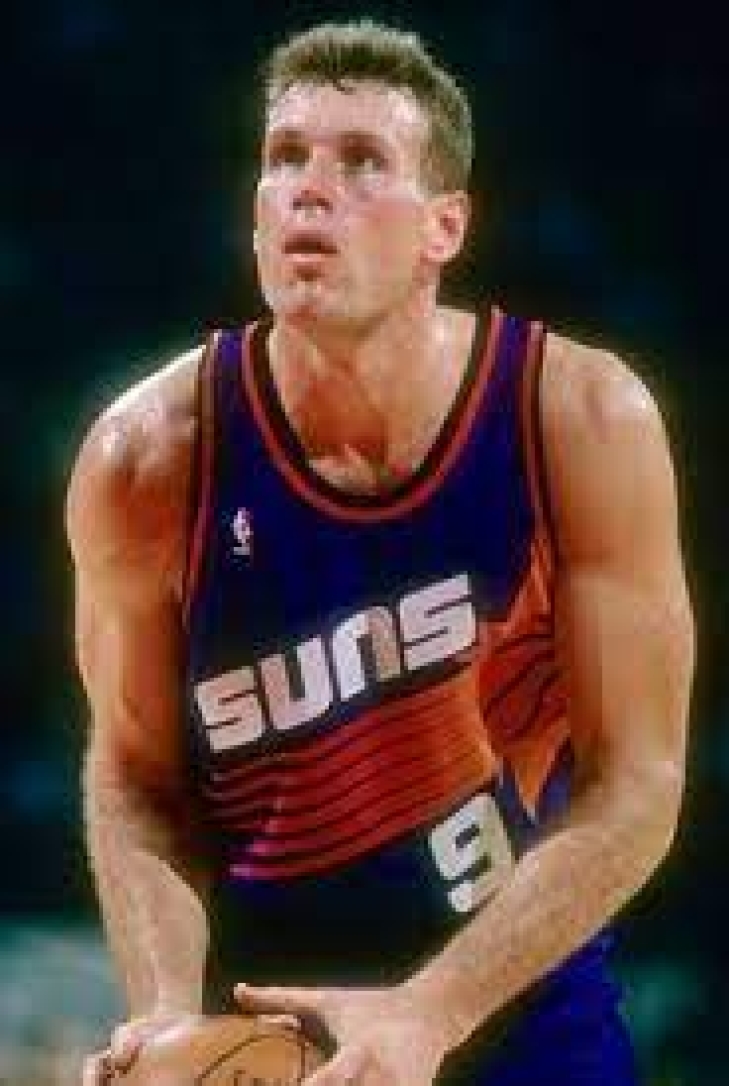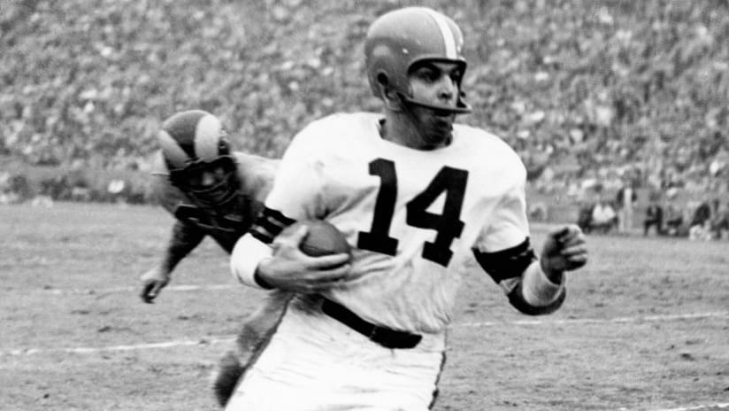
Committee Chairman
93. Mel Hutchins
Mel Hutchins led BYU to an NIT Title in 1951, and the Second Team All-American was drafted Second Overall the year after by the Tri-Cities Hawks, who moved to Milwaukee right after.
Hutchins was incredible in his first pro year, where he became the first rookie to lead the NBA in rebounds. Named by the sportswriters as their Rookie of the Year, Hutchins became a more balanced player, averaging a double-double as a sophomore (11.7 Points and 11.2 Rebounds) and was an All-Star for the first time.
The struggling Hawks sold his rights to the Fort Wayne Pistons, where he was on a much better team. Hutchins went to three more All-Stars and helped them reach back-to-back Finals in 1955 and 1956. He was also fourth and eighth, respectively, in MVP voting in those seasons. Hutchins was dealt to New York in the 1957 off-season, but a devastating knee injury ended his career. He only played 18 Games that year and never competed again.
The staunch defender is a “what might have been” in a sport littered with them, but there were many accolades in that brief career.
Drew Brees named to the New Orleans Saints Hall of Fame
Regular visitors of Notinhalloffame.com know that we are slowly working on the top 50 of every major team in the NHL, NBA, NFL, and MLB. Once that is done, we will look at how each team honors its past players, coaches, and executives. As such, it is important to us that the Pittsburgh Pirates have announced that Drew Brees and Doug Moreau to their franchise Hall of Fame.
Drew Brees played the first four years of his career with the San Diego Chargers, but after they drafted Philip Rivers, Brees became expendable. Brees was also coming off shoulder surgery, and many teams were a little gun shy about signing the former Purdue Boilermaker. He did, however, have offers, and he signed with the New Orleans Saints before the 2006 season. That decision turned out to be the best for both parties.
We are entering 2020, and Drew Brees is still the Saints Quarterback, and what he has done for the Saints and the city of New Orleans is impossible to quantify. He shed any immediate fear about his shoulder in his first year there, with a Pro Bowl and a first-place finish in Passing Yards. These stats were especially impressive considering New Orleans was suffering from the aftermath of Hurricane Katrina, and it was their first year back as they were unable to play in Louisiana during the '05 season. Brees was not just a Saint but was the face of the city and a community leader.
Since the time he has been a Saint, Brees has always been considered among the top five in NFL Quarterbacks. In the Big Easy, Brees has been to the Pro Bowl twelve times, has been a First Team All-Pro once, a Second Team All-Pro four times, led the league in Passing Yards seven times and Passing Touchdowns four times. More importantly, Brees took New Orleans to a win at Super Bowl XLIV, a feat even more impressive considering that the Saints were almost at the point of relocation. It is not unrealistic to state that had Brees not signed with the Saints, and we might be calling them a completely different team right now.
Injuries would take their toll on Brees in 2019 and 2020, and while he was still a productive player, he hung up the cleats after the 2020 season. At the time of his writing, Brees was the all-time leader in Passing Yards, and was second in Touchdown Passes, most of which was accomplished as a Saint.
Moreau enters the Hall for his vast contributions to the team, including entering his 27th year as their press box announcer and 52nd as public address announcer.
We here at Notinhalloffame.com would like to congratulate Drew Brees and Doug Moreau for this impending honor.
89. Dan Majerle
Dan Majerle was one of the greatest players in Central Michigan’s basketball history. He earned All-MAC honors three seasons in a row (1986-88), and the Chippewas retired his number 44 years later. His college career landed him a First-Round pick in 1988 by the Phoenix Suns, the professional team he had his greatest success with.
The Suns fans were initially upset with Majerle’s selection. He didn’t look like much, and he came from a smaller D1 school. It didn’t take long for Majerle to win over the fan base, with his strong transition game, solid defense and long-range shooting. Majerle was a Second Team Defensive Team in 1991 and 1993, mostly off the strength of ability to glove his opponents. A three-time All-Star, Majerle led the NBA twice in 3-Point Field Goals twice (1993-94 & 1994-95). He also played a large part in the Suns’ run to the NBA Finals in 1993, where they lost to Michael Jordan and the Chicago Bulls in six games.
After his peak in Phoenix, Majerle played for Cleveland for a year and then Miami for five, though his role reduced annually. After a final year back with the Suns, Majerle retired with a solid basketball career behind. with a FIBA Gold Medal and a retired number with the Suns. That sounds pretty good to us!
Pro Football Hall of Fame Revisited Project: 1961 FINAL VOTE
1961 Pro Football Hall of Fame Revisited Project Class.
Here we are! Again!!
If you have been following our Pro Football Hall of Fame Revisited Project, you know that we have asked the rhetorical question: What if the PFHOF began in January 1946?
After soliciting and obtaining a passionate group of football fans and historians, we sent out a ballot for a Preliminary Vote, in which we asked each voter to give us 25 names as their semi-finalists and 5 in the Senior Pool. Following that, we asked the group to vote for their 15 Finalists in the Modern Era and 3 in the Senior Category. The final stage was to vote for their five Modern Era inductee and one Senior inductee.
This is the result of the sixteenth official class;
Below are the final results of this project based on 31 votes,
Remember that the group took a vote in “1961”, and we have reverted back to the top five candidates entering the Hall PROVIDING THEY MAKE 50% of the vote. This will be put to a vote again in “1963”.
This is for the “Modern Era”
*Bold indicates they have been elected to the Pro Football Hall of Fame Revisited Class of 1961:
|
Player |
Year of Eligibility |
Vote Total |
|
Otto Graham QB |
1 |
31 |
|
Marion Motley FB |
1 |
28 |
|
Pete Pihos E-DE |
1 |
19 |
|
Charley Trippi HB-QB-DB |
1 |
17 |
|
Doak Walker HB-DB |
1 |
15 |
|
George Connor T-LB-DT-G |
1 |
10 |
|
Ward Cuff WB-QB-HB |
9 |
6 |
|
Marshall Goldberg FB |
8 |
6 |
|
Joe Kopcha G |
20 |
5 |
|
Dick Barwegan G |
2 |
5 |
|
Buckets Goldenberg G-BB |
11 |
4 |
|
Bill Osmanski FB |
9 |
2 |
|
Lou Rymkus T |
5 |
2 |
|
Ed Sprinkle DE-E-G-LB |
1 |
2 |
|
Pat Harder FB |
3 |
1 |
This is for the “Senior Era”, *Bold indicates they have been elected to the Pro Football Hall of Fame Revisited Class of 1961, though no one made the mandatory 50% threshold to advance.
|
Tony Latone |
6 |
12 |
|
Hunk Anderson |
11 |
10 |
|
None of the Above |
N/A |
5 |
|
Al Nesser |
5 |
4 |
About the 1961 Inductees:
Otto Graham QB-DB, CLE 1946-55: Inducted in the Pro Football Hall of Fame Revisited Project in 1961 on his 1st Ballot. Inducted into the actual Pro Football Hall of Fame in 1965.
Otto Graham was the first player that Cleveland Browns owner; Paul Brown, sought when he assembled his team in 1946 to begin play in the All-American Football Conference. Brown was right to convert the Northwestern Tailback to a pro Quarterback in the T-Formation. Graham and the Browns dominated the AAFC, and without question, Graham was the best player in the upstart league. The Browns won every single title in the four-year existence of the AAFC, and Graham was at the forefront of that success. The AAFC would merge with the NFL, and it was expected that those teams would not be successful in the first few years of the unification. They were wrong. The Browns won the 1950 NFL Championship, thus proving the merit of the AAFC; Graham won two more NFL Championships and was, overall, a five-time league leader in Passing Yards. In the ten years he played, there was never a year where he didn’t at least take the Browns to a Division Title.
Marion Motley FB-LB, CLE 1946-55: Inducted in the Pro Football Hall of Fame Revisited Project in 1961 on his 1st Ballot. Inducted into the actual Pro Football Hall of Fame in 1968.
While there were African Americans in pro football before Marion Motley, they had been phased out, but after World War II, this was about to change. Motley tried out for the Cleveland Browns of the new All-American Football Conference, and he made the team and would become oone f the best players in team history. Motley was an excellent rusher who won the AAFC Rushing Title in 1948, and the NFL Rushing Title in 1950, and he was a large part of the Cleveland juggernaut that won all four AAFC Championships and the 1950 NFL Championship. He was also incredibly valuable as a blocker and helped open up Otto Graham’s passing game. Motley had 5,827 Yards From Scrimmage, an excellent total for his era.
Pete Pihos E-DE, PHI 1947-55: Inducted in the Pro Football Hall of Fame Revisited Project in 1961 on his 1st Ballot. Inducted into the actual Pro Football Hall of Fame in 1970.
A three-time All-American at Indiana, Pete Pihos played his entire nine-year career with the Philadelphia Eagles, beginning as a two-way end, but eventually specializing in the offence. Pihos was one of the top receivers in the late 1940s and early 1950s, aiding the Eagles in back-to-back NFL Championships (1948 & 1949), and securing five First Team All-Pro Selections. In 1953, Pihos began a three-year streak leading the NFL in Receptions, with him also finishing first in Receiving Yards in the bookend seasons. He would accumulate 5,619 Yards with 61 Touchdowns.
Charley Trippi HB-QB-DB, CRD 1947-55: Inducted in the Pro Football Hall of Fame Revisited Project in 1961 on his 1st Ballot. Inducted into the actual Pro Football Hall of Fame in 1968.
Charley Trippi was a coveted player coming out of the University of Georgia, and the New York Yankees of the upstart All-American Football Conference thought they had him locked up. The Chicago Cardinals, who drafted him first overall, earned his services when Cardinals owner, Charles Bidwell signed him to what was a huge contract at the time, $100,000 over four years. Trippi was the heart of what would become Chicago’s “Million Dollar Backfield” and as a rookie in 1947, he would lead the Cardinals to an NFL Championship. Incredibly versatile, Trippi could play any offensive skill position and excelled at rushing, passing and punting. He played until 1955, finishing his career with the Cardinals and amassing 4,827 Yards From Scrimmage.





